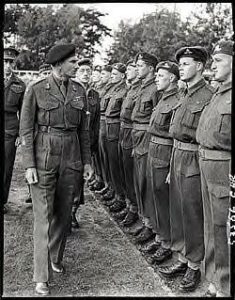
x
e-veritas has been given permission to publish excerpts of 5105 Doctor J. L. Granatstein’s (CMR RMC 1961) interviews (1991-1993) for “The Generals: the Canadian Army’s Senior Commanders in the Second World War”. 5105 Doctor J.L. Granatstein fonds are at the National Defence HQ Directorate of History and Heritage.
x
x
___________________________________________________________________________________________________
2297 Major General Robert P. Rothschild MBE, CD (RMC 1932)
2297 Major General Robert P. Rothschild MBE, CD (RMC 1932) was interviewed by 5105 Doctor J.L. Granatstein in Ottawa on 24 May 91. Rothschild served in the Permanent Force in the Royal Canadian Horse Artillery. During WWII, he served as a staff officer. After a stint with 2 Armd Bde, Rothschild became GSO 1 of II Corps during the Falaise operations. He died on 1/30/2000.
On RMC:
The attitude to RMC people was not very good and it took time to get integrated. Still, there was no sign of an old boy network, though certainly it helped to know senior officers.
On Permanent Force:
He thought the Permanent Force were professional, though not quite as much as present (c. 1991) regulars. Many had war experience including many senior Non Commissioned Officers. The Captains and down were largely postwar. Essentially their role was to be a training cadre for the militia which was not of very high quality–though better than the present (c. 1991) reserves and more enthusiastic.
On training:
Training generally was of low standard until 1941-2 when it began to achieve fighting capacity. Still, this was mostly individual training. Remember not a single div (except possibly 4th) arrived in UK in a good state of training.
On Conscription:
He heard rumours but saw very little sign of a problem. Certainly it didn’t hinder II Corps operations.
On Artillery:
There was an artillery protective society, but artillerymen rose because the combination of the technical and tactical in arty and because the provision of fire support demanded tactical skills.
On 1596 General Guy Simonds (RMC 1921-5):
Rothschild remembered an incident in the prewar RCHA mess when the Commanding Officer Stockwell asked the battery commanders their ambitions: Simonds–I’m not stopping until I’m Chief of the Imperial General Staff (CIGS). When Simonds went to the Imperial Defence College in 1946, there were rumours he was transferring to UK Army, but he squelched them at a farewell mess dinner.[General Simonds was Chief of the General Staff from 51-55]
In 1940, General Simonds took over the RCHA command and Rothschild was Adjutant. The regiment was bruised and had only its 24 guns left after Brest (as well as l picked up on the road from a United Kingdom regiment. As CO, Simonds was first rate. He undertook basic training and did beautifully–he had been one of the best prewar gunnery instructors (he was an excellent gunner) and he was an excellent CO in training men. He related to the gunners, even if he frightened the junior officers. Rothschild had met him at Petawawa in 1935 but didn’t know him well until l940.
Lieutenant General Guy Simonds inspecting II Canadian Corps in Meppen, Germany, May 31st, 1945
He was as good a CO as one could have and was also understanding. Simonds, for example, told Rothschild to work out a training plan and, without staff training, Rothschild had no idea how to do it. Eventually he went to Simonds and admitted this and Simonds spent a half day explaining what to do. Thereafter Rothschild was expected to understand. He was very demanding in a professional way. In the mess Simonds played the Commanding Officer`s role and took part, if a little stiffly. Rothschild went to a staff course, run by Simonds, who was excellent, simply good at anything he tackled. He could talk about anything, not just military matters. The plans were Simonds and so were the innovative ideas. Simonds picked peoples’ brains, talked to specialists, and then produced ideas. Simonds was approachable. Simonds was good at talent spotting. He had a few friends. He didn’t tolerate fools or incompetents–even as RCHA CO, he canned one bad apple on the spot who arrived in a group of reinforcement officers.
Simonds, who was Commander of the 2nd Canadian Corps in NW Europe, 1944-45 picked Rothschild to succeed Moncel. There was no panic when he arrived, though the Corps had only been in operations for a few weeks and the battles were big. GGS had really taken hold and was whipping it into shape–in the UK there hadn’t been much Corps activity. Simonds ran a tight ship, and if he sacked people, he put in others he could count on. It was a very strong team, and Simonds` O Gps were models of brevity, clarity, simplicity. You always had the feeling that if everyone did what Simonds said they should do, the ops would go well. He ran a happy ship, simply inspired confidence, and he thinks the troops felt this too. They knew Simonds was in command, and he got around visiting units. He knew more about what was going on than anyone.



